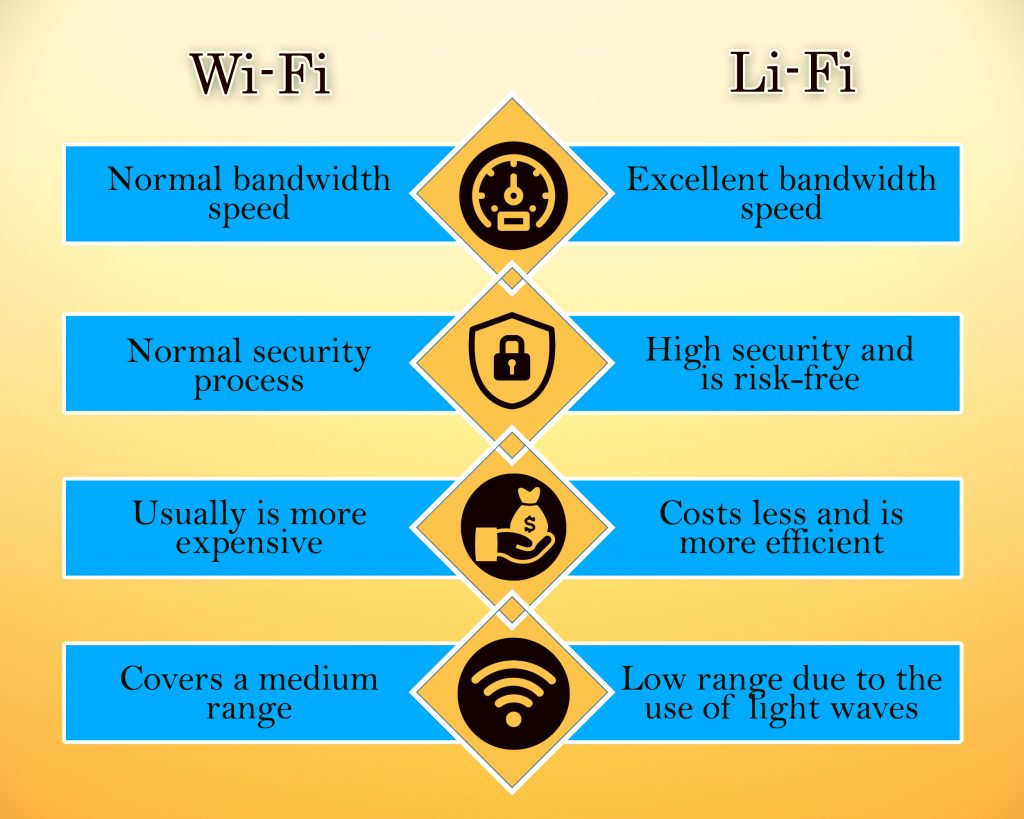Introduction:
Today’s world exists in a digital space. The never-ending hunger for better technology is bringing advances every single day. When it comes to the internet, everyone is looking for an option with more data packs and better data speed. There are many technologies like IoT, Virtual reality, Augmented Reality, and Artificial Intelligence which can totally transform our future. But, there are some other technologies which are also capable of dynamic transformations like Li-Fi or Light Fidelity.

Li-Fi is a technology for transmitting data. It uses visible light and ultraviolet light to fulfill the communication process. This term was first used by Harald Hass in a TED conference back in 2011. This technique is useful for transmitting data over wireless connections in a restricted area. In addition, it proves to be a better tool in comparison to Wi-Fi. It provides safety over the network, high data speed, and more efficiency. This means that data can be transmitted through the light which is a very practical solution to the current data transmission problems.
Let’s take a look at the current scenario. Today, people prefer Wi-Fi for wireless data transmission. But, we haven’t yet fully realised the potential of this bi-directional wireless technology. It has been improved tremendously to provide users with high-speed internet, data safety, and efficient data transmission. When using light as a medium, the data is transmitted 100 times faster than that of a Wi-Fi. This means that it can prove to be a better medium for data transmission than Wi-Fi.
Difference Between Li-Fi and Wi-Fi
It is important to understand that both these technologies are different from each other and not similar. Below listed are a few key differences between both wireless data transmission technologies.
Bandwidth speed – Wi-Fi has a normal bandwidth speed, while a Li-Fi has an excellent speed which is almost 100 times faster than Wi-Fi.
Safety – WiFi has a normal security process, with cases of misuse of data. Li-Fi has high security and is risk-free because it uses harmless light waves.
Cost-effective – WiFi usually is more expensive. On the other hand, Li-Fi costs less and is more efficient.
Range – WiFi covers a medium-range whereas Li-Fi has a low range due to the use of light waves.
How does Li-Fi Work?
The system consists of two parts, mainly the transmitter and the receiver. The transmitter has an input signal which can be tempered with a certain time schedule. Next, the data is sent using LED bulbs which are in 0’s and 1’s. This can be identified through the flash on the bulbs. The receiver has a photodiode which gets the LED flashes, identifies the signals, and produces the output.
The transmitter has different parts including timer circuit, input, and an LED bulb. Input here refers to data in any form like text, images, voice, and such. The timer circuit is used to maintain time intervals between the specific time period. On the other hand, a receiver consists of a Photodiode and an amplifier. The Photodiode converts LED flashes into electric signals, whereas the latter converts the signals into outputs.
Let’s dwell a little deeper. Li-Fi works on a Visible Light System or VLC, which means that it has a high data speed. A normal LEd is used to transfer this data where the speed can go up to 220 gigabytes per second. This data transmission is also conducted through illumination. For this purpose, we will need a flashing light-emitting diodes.
Mertis of Li-Fi
In order to understand how useful this technology can be in the near future, let’s consider a few merits or advantages of this technology.
Data Transmission Speed – The speed of light is 299 792 458 m/s. If we use light for communication, it will provide more speed than Wi-Fi, i.e. around 10 to 20 Gbps.
Sensitive areas – This technology is useful in electromagnetic areas like Hospitals. These places would have no interference and would allow the data to transmit smoothly.
No visibility – In order to function properly, the light is not required to be at a level visible to the human eye. It can be at a reduced intensity and still work fine to transmit data over wireless connections.
No risk – LiFi utilises those light waves which are reliable and pose no risk to safety or data privacy.
Demerits of Li-Fi
We need to consider both sides of the coin. In addition to the merits, there are some potential risks or problems while using this technology. Let’s analyse the risks.
Area Limitations – It is not possible for light to pass through opaque objects like a wall. This is why the transmission is restricted. However, this can be solved by adding sensors. The light can be reflected on a wall as a direct pathway isn’t necessary. But, this would lead to a significant reduction in data speed.
Range problem – LiFi is not capable of covering long ranges, i.e. more than 5-10 metres. This is because the light beam cannot be transmitted for more than 5-10 m. When you add sensors for solving the problem of opaque objects, you also increase the distance. This ultimately adds to the current problem.
External light sources – In situations when there is interference from external light sources like sunlight or regular bulbs, the transmission process would be hindered. It cannot transmit data with such interference.
Conclusion:
Light Fidelity is a promising technology to transform the future. It works with a transmitter and a receiver. The technology utilises light waves for higher speed of data transmission and efficiency. But, on the other hand, it is not being widely used in the current scenario. This is because there are some potential disadvantages at the moment. The developers are working on solving this problem. There are some genuine problems like opaque objects, long-range and external light sources. These have to be worked upon. If improved and advanced, it may replace the wi-fi technology entirely in the near future.


Leave a Reply